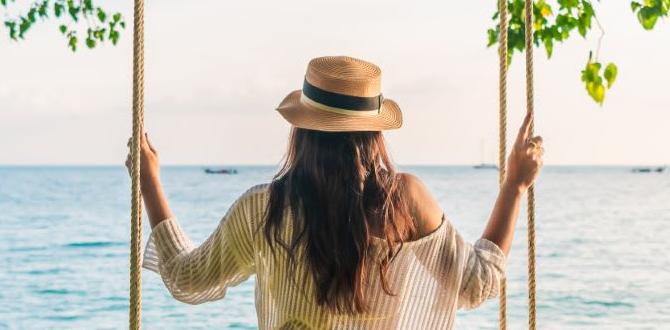Bali Ubud No-Crowds Itinerary: Essential Guide
Dreaming of a serene Ubud escape without the usual hustle? This essential guide unlocks a Bali Ubud no-crowds itinerary, showing you how to experience its magic – the rice terraces, temples, and tranquil vibes – peacefully. Discover hidden gems and smart timings for an unforgettable, stress-free journey.
Ubud, Bali, is a place many travelers dream of – think lush green rice fields, spiritual temples, and a wonderfully calming atmosphere. But sometimes, the reality of visiting can feel a bit overwhelming with large crowds, especially at popular spots. It’s a common frustration for visitors wanting to truly soak in the beauty and tranquility that Ubud is famous for. We get it! You want those breathtaking photos without a hundred people in them, and peaceful moments to connect with the magic of the Monkey Forest or the Campuhan Ridge Walk.
Don’t worry, with a little planning, you can absolutely experience the best of Ubud without the crowds. Journey Essentials is here to help you craft the perfect Bali Ubud no-crowds itinerary. We’ll guide you through smart timing, lesser-known spots, and practical tips to ensure your trip is as peaceful and enjoyable as you imagined. Get ready to discover Ubud’s serene side!
Frequently Asked Questions
When is the best time of year to visit Ubud for fewer crowds?
The shoulder seasons are your best bet! Consider visiting during the dry season months of April, May, June, or September/October. You’ll find pleasant weather and significantly smaller crowds compared to the peak summer months (July/August) or the Christmas holiday period.
What are some “off-the-beaten-path” temples near Ubud?
While Tirta Empul and Goa Gajah are popular, consider Pura Kehen in Bangli (a bit of a drive but stunning) or Pura Gunung Kawi Sebatu. These offer a more intimate spiritual experience without the tourist throngs.
How can I avoid crowds at the Tegalalang Rice Terraces?
Visit very early in the morning, right at sunrise, or late in the afternoon. Alternatively, explore some of the smaller, less accessible terraces away from the main viewpoints. Wearing comfortable walking shoes is essential for navigating the paths.
What essential items should I pack for a serene Ubud trip?
Pack light, breathable clothing, comfortable walking shoes, insect repellent, sunscreen, a hat, and a reusable water bottle. For peace of mind during longer travel days or unexpected needs, consider packing discreet personal care items like adult or child diapers, ensuring comfort and readiness for any situation.
Are there any quiet spots for yoga or meditation in Ubud?
Absolutely! Beyond the popular studios, look for smaller, community-focused yoga shalas or meditation centers nestled in quieter village areas. Many resorts also offer private or small-group sessions in tranquil garden settings.
What’s the best way to get around Ubud to avoid traffic and crowds?
Hiring a private driver for specific day trips is often the most efficient and comfortable. For shorter distances within town, consider walking or renting a scooter (if you’re an experienced rider). Ride-hailing apps like Gojek are also available but can be slow during peak traffic.
Pre-Trip Planning for a Peaceful Ubud
Your tranquil Ubud adventure starts long before you step onto the plane. By doing a bit of pre-trip groundwork, you’ll set yourself up for a much more relaxed and crowd-free experience. This isn’t about endless to-do lists; it’s about making smart, simple choices that pay off big time once you’re there.
The key to a no-crowds itinerary lies in understanding Bali’s rhythm. Think about when most people visit, when popular spots are at their busiest, and how you can cleverly work around those peak times. It’s about being a savvy traveler, not a stressed one!
Choosing the Right Time: Avoiding the Peak Rush
Bali is a year-round destination, but certain times are undeniably more popular. The absolute peak season, which means more people and higher prices, generally falls between June and August, and again from late December to early January for Christmas and New Year. If you’re aiming for fewer crowds, these are times to avoid if possible.
The Magic of the Shoulder Seasons
Your sweet spot for fewer crowds and great weather is during the shoulder seasons: April to May and September to October. During these months, the weather is still fantastic – sunny and warm, but with a little less humidity than the height of the wet season. You’ll find that most attractions are far less congested, allowing for a more intimate experience with the Balinese culture and scenery.
Understanding Bali’s Seasons
Bali has two main seasons: the dry season (April to October) and the wet season (November to March). While the wet season can bring heavy, short-lived downpours, it often means fewer tourists and lush, vibrant landscapes. If you’re flexible and don’t mind the occasional rain shower, the wet season can also be a great time for a quieter visit, especially outside of the Christmas holidays.
Here’s a quick look at what to expect:
| Season | Months | Crowd Levels | Weather | Pros for No-Crowds |
|---|---|---|---|---|
| Shoulder Season (Dry) | April – May | Low to Moderate | Sunny, warm, less humid | Great weather, fewer tourists than peak |
| Peak Season (Dry) | June – August | High | Sunny, dry, pleasant | Best weather, but most crowded |
| Shoulder Season (Dry) | September – October | Moderate | Sunny, warm, transitioning to wetter | Still good weather, crowds begin to lessen |
| Wet Season | November – March | Low (except Dec/Jan) | Humid, frequent rain showers | Significantly fewer tourists outside holidays, lush greenery |
Smart Booking for Stress-Free Travel
To ensure a smooth trip, especially when aiming for a no-crowds experience, booking your accommodation and any essential tours in advance is wise. This doesn’t mean you can’t be spontaneous, but securing your preferred quiet guesthouse or that early morning yoga class can make all the difference.
Consider booking accommodations slightly outside the very center of Ubud town. Many beautiful villas and guesthouses are nestled in the surrounding villages, offering peace and quiet while still being a short drive or scooter ride away from the main attractions. This is also where you can find more unique, locally-run places.
Your Ubud No-Crowds Itinerary: A Sample Plan
This itinerary is designed to help you experience the essence of Ubud while strategically avoiding the busiest times and places. It balances iconic sights with hidden gems for a truly memorable and peaceful journey. Remember, this is a template – feel free to adjust it to your pace and interests!
Day 1: Arrival & Gentle Exploration – The Calm Before the Buzz
Morning (Arrival & Settle In)
- Arrive at Ngurah Rai International Airport (DPS).
- Pre-book a private transfer to your accommodation in Ubud. This is far more relaxing than navigating airport taxis.
- Check into your hotel or villa. Choose a place slightly away from the main Ubud road if possible for maximum tranquility.
Afternoon (Serene Nature Walk)
- Campuhan Ridge Walk (Early Afternoon): Head to the Campuhan Ridge Walk before the late afternoon rush. Aim for around 2:00-3:00 PM. The light is beautiful, and you’ll encounter fewer people than at sunset. It’s a relatively easy walk with stunning valley views. Wear comfortable shoes and bring water. You can find more tips on enjoying this walk from Bali.com.
Evening (Quiet Dinner)
- Enjoy a leisurely dinner at a restaurant in a quieter part of town or at your accommodation. Look for places with garden settings, which often feel more peaceful.
Day 2: Spiritual Sites & Cultural Immersion – Finding Inner Peace
Morning (Early Temple Visit)
- Tirta Empul Temple (Very Early Morning): This holy water temple is incredibly popular. To experience its spiritual aura without the crowds, you must go as early as possible, ideally between 7:00 AM and 8:00 AM. You can participate in the cleansing ritual if you wish, but respect the local customs and dress appropriately (sarong provided or bring your own).
Late Morning (Rice Terrace Tranquility)
- Tegalalang Rice Terraces (Mid-Morning): After Tirta Empul, head to the Tegalalang Rice Terraces. Visiting mid-morning (around 9:30-10:30 AM) will be less crowded than midday or sunset. Explore some of the less-trafficked paths to get those iconic photos in peace.
Afternoon (Art & Sanctuary)
- Ubud Art Market (Early Afternoon): Browse the Ubud Art Market in the early afternoon. It will still be lively, but less intense than during lunch or mid-afternoon peaks.
- Sacred Monkey Forest Sanctuary (Late Afternoon): This is a popular spot, so visiting late afternoon, perhaps around 3:30-4:30 PM, can mean fewer school groups and families. Be mindful of the monkeys and secure your belongings. For safety guidelines, consult the official Sacred Monkey Forest Ubud.
Evening (Relaxed Pace)
- Consider a traditional Balinese dance performance at a smaller venue or simply enjoy a quiet evening reflecting on the day’s experiences.
Day 3: Nature Retreats & Hidden Gems – Beyond the Postcards
Morning (Hidden Waterfalls or Temples)
- Option A: Tegenungan Waterfall (Early Morning): If you want to see a waterfall, go to Tegenungan as early as possible (7:00-8:00 AM) to avoid the large tour groups.
- Option B: Pura Gunung Kawi Sebatu (Mid-Morning): For a more serene temple experience, visit Pura Gunung Kawi Sebatu. This beautiful temple complex with ponds is often overlooked by larger tourist groups, offering a peaceful atmosphere.
Late Morning/Afternoon (Relaxation & Local Life)
- Organic Farm Visit or Cooking Class: Many places offer tours of organic farms or hands-on Balinese cooking classes. These are often small, intimate groups and provide a wonderful way to connect with local culture and cuisine away from the main tourist hubs.
- Explore Sidemen Valley: If you have a driver, consider a trip to the Sidemen Valley (about 1-1.5 hours from Ubud). It’s like Tegalalang but less developed and far less crowded, offering stunning rice paddy views and a glimpse into rural Balinese life.
Evening (Wellness Focus)
- Indulge in a Balinese massage at a reputable spa. Look for smaller, well-reviewed spas rather than the large, busy ones.
- Enjoy a quiet dinner featuring healthy, local ingredients.
Day 4: Activities & Departure Preparation – A Gentle Farewell
Morning (Sunrise or Leisurely Start)
- Option A: Sunrise Views: If you’re an early riser, revisit a favorite spot like Campuhan Ridge for sunrise, or simply enjoy the quiet morning from your villa.
- Option B: Yoga or Meditation: Attend a yoga or meditation class at a less frequented studio or resort class. Many offer serene settings conducive to mindfulness.
Late Morning (Souvenir Shopping & Local Flavors)
- Visit a local coffee plantation for Kopi Luwak tasting (research ethical plantations beforehand) or stock up on any last-minute gifts from smaller artisan shops rather than the main market.
- Grab a final delicious and healthy Balinese meal at a charming cafe.
Afternoon (Departure)
- Check out of your accommodation.
- Arrange a pre-booked transfer back to the airport, allowing ample time for travel.
Practical Tips for a Seamless, Crowd-Free Experience
Beyond the itinerary, a few practical hacks can make your Ubud trip significantly more enjoyable and peaceful. These are simple, actionable tips that focus on comfort and convenience, making sure you can focus on soaking in the beauty of Bali.
Smart Transportation Strategies
Traffic in and around Ubud can be challenging. To avoid frustration and make the most of your time:
- Hire a Private Driver: For day trips and exploring further afield, a private driver is invaluable. You can customize your itinerary, stop whenever you like, and avoid parking hassles. Negotiate rates beforehand.
- Scooter Rental (Experienced Riders Only): If you are a confident and experienced scooter rider, this offers the most freedom for short distances within Ubud. Always wear a helmet and be aware of local traffic conditions.
- Walking: For exploring central Ubud, walking is often the quickest and most pleasant way, allowing you to discover quirky shops and cafes.
- Ride-Hailing Apps: Apps like Gojek and Grab are available but can face delays during peak hours. They are useful for shorter hops.
Dressing for Comfort and Culture
Comfort is key, especially in Bali’s tropical climate. Pack light, breathable fabrics like cotton and linen. Remember that many temples require modest dress:
- Lightweight clothing: T-shirts, loose-fitting pants, skirts, and dresses are ideal.
- Modest attire for temples: Ensure you have trousers or a long skirt and a shirt with sleeves. A sarong is often required and can be rented at temple entrances, but having your own lightweight one is convenient.
- Comfortable footwear: Sandals, flip-flops, and comfortable walking shoes are essential. You’ll be taking your shoes off frequently at temples and some eateries.
Staying Hydrated and Prepared
Bali is hot and humid. Staying hydrated is crucial. Carrying a reusable water bottle is eco-friendly and economical. You can refill it at your hotel or many cafes.
For those who might need them, discreet personal care items can make a big difference in travel comfort. If you or a family member uses adult diapers or child diapers for long flights, health reasons, or unexpected situations, packing an adequate supply ensures peace of mind and dignity. Companies specializing in adult diapers offer a range of products designed for maximum absorbency and discretion, ideal for travel.
Respecting Local Customs
Bali is deeply spiritual. Showing respect for local traditions will enhance your experience:
- Temple Etiquette: Dress modestly, ask permission before taking photos, and never point your feet towards a sacred object.
- Sacred Sites: Be mindful of your voice and behavior in religious places.
- Donations: While not always mandatory, small donations are appreciated at smaller temples to help with upkeep.
Food and Drink Safety
Ubud has a fantastic food scene, from local warungs to trendy cafes. Generally, it’s safe to eat out, but:





